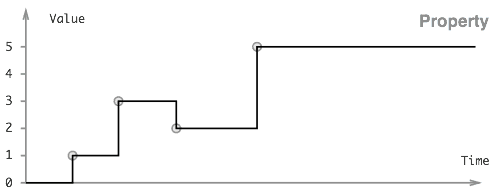Event streams vs Properties in Bacon.js
Published on September 21, 2016 under the category Functional reactive programmingIn Bacon.js we operate with two different types of observable data types: Event Streams and Properties. Here's a brief explanation of what these concepts are along with some concrete examples to illustrate when to choose one over the other.
Event streams represent discrete values over time
You can think of event streams as lists of events happening over time.
[(t1, v1), (t2, v2), ..., (tn, vn), ...]
Examples of event streams are:
- Mouse clicks on a button:
const clickStream = Bacon.fromEvent(document.querySelector('#button'), 'click');- Keystrokes on an input field:
const keyStream = Bacon.fromEvent(document.querySelector('#input'), 'keyup');- A promise that resolves after hitting an API and coming back with data:
const ajaxCall = axios.get('//your.api.com/endpoint');
const dataStream = Bacon.fromPromise(ajaxCall);Note that for these examples, talking about an initial value wouldn't make any sense. Also, these streams will only happen to have a value (ie: event) pushed down the stream when the user either clicks on the button or presses a key on the input field, or when we hear back from the API. Remember that clicking on the button means pushing that click event onto the stream: our value is the click event itself.
Properties introduce the notion of continuous values
Properties represent values that change over time. The value of a property changes in response to events, which means that any stream may be easily converted into a property.

In most ways properties behave very much like event streams. The main differences between the two are:
- Properties can have an initial value. They don't always do, though: depending on how a property is created, it may or may not have one.
- Properties remember or hold the last value they've received. This means properties are continuous, as opposed to event streams which are discrete. The only exception to this rule is when a property doesn't get assigned an initial value when it gets created.
- The current value stays as its last value even after the stream has ended.
Examples of properties are:
- The position of our mouse cursor determined by any series of movements:
const mouseProperty = Bacon.fromEvent(document, 'mousemove')
.map((event) => `(${event.x}, ${event.y})`)
.toProperty();- The value of an input field at any given time:
const inputProperty = Bacon.fromEvent(document.querySelector('#input'), 'keyup')
.map('.currentTarget.value')
.toProperty('This is the default value');The Observable interface
Both streams and properties implement the Observable interface, meaning they share a lot of methods: onValue, onError, fromPromise,
map, among many others. Check out the full list of shared methods
here.
These methods typically return another observable to allow for further chaining. Of course, there are exceptions (such as onValue).
Assigning values to DOM elements (or how to purposely create side effects)
This concept of "current value" makes properties great for assigning values and attributes to DOM elements. Bacon provides a helper method for assigning the value of a property to a DOM node:
property.assign(nodeElement, setterMethod [, ...args])This calls the method setterMethod of the given nodeElement whenever the value of the property changes (even for the initial
value!). You can optionally provide arguments which will get passed in onto the setter method.
So, if you want to hide or show a button based on the value of a property, you could do something along the lines of:
buttonVisibilityProperty.assign($('#my-button'), 'toggle');Here the value of the property gets automagically passed in onto toggle(). Also, we assume we are dealing with a boolean property here.
Now, chances are most of us aren't using jQuery in our projects. How can we make assign() work with our vanilla JS DOM manipulation
skills?
DOM nodes, when not wrapped in the jQuery object, don't have setter methods like attr(), html() or text(). That's why assign isn't
quite the best option out there if we don't use jQuery.
Probably an example will help see this better: let's say we extend our HTMLInputElement prototype, which is sort of what jQuery does
(this is bad though! don't do it, my intent is just to showcase why we can't usually resort to assign() for updating the DOM without
jQuery):
HTMLInputElement.prototype.setValue = function (message, value) {
this.value = value;
console.log('clicked', message);
};
Bacon.fromEvent(document.querySelector('#button'), 'click')
.map(1)
.scan(0, (accumulator, value) => accumulator + value)
.assign(document.querySelector('#input'), 'setValue', 'rawr');We can even pass in a third argument. If we do, those arguments we pass in are gonna come first than the property value. See how on the
prototype method message comes before the actual value? So, what do we do if we want to mutate the DOM state based on the value of a
property but can't use assign()? Well, assign is nothing more than a fancy version of onValue(). We could do the following:
const button = document.querySelector('#button');
const input = document.querySelector('#input');
Bacon.fromEvent(button, 'click')
.map(1)
.scan(0, (accumulator, value) => accumulator + value)
.onValue((count) => (input.value = count));Note we can use assign() only with properties, but we can use onValue() in this way with event streams as well.
Creating properties from event streams
There are a couple methods you can use to turn your event stream into a property:
stream.toProperty(initialValue)creates a property based on the event stream. Passing in an initial value is optional. If we don't provide one, the property will get its first value from the stream, and will always hold a value thereafter. Here's a super simple example that logs out the current timestamp for every click on a button:
const counter = Bacon.fromEvent(document.querySelector('#button'), 'click')
.map(() => Date.now())
.toProperty('initial value')
.onValue((value) => {
console.log(value);
});Just out of curiosity, have a go at what happens if you replace () => Date.now() within map() with just Date.now().
- We can also
scan()andfold()event streams to convert them into properties. These are similar toreduce()in functional programming — think ofArray.prototype.reduce(). An example ofscan()is the counter we built before when we went through howassign()works.
Note that fold() is a little bit different from scan(). Consider this example:
Bacon.fromArray([1, 2, 3, 4])
.scan(0, (accumulator, value) => accumulator + value)
.onValue((value) => {
console.log(value);
});We will get all intermediate values logged out to the console: 0, 1, 3, 6 and 10. That is, the property updates for every single calculation.
Bacon.fromArray([1, 2, 3, 4])
.fold(0, (accumulator, value) => accumulator + value)
.onValue((value) => {
console.log(value);
});fold(), on the other hand, will only emit a value and log to the console after going through all of the elements in the array (ie: will
only log out the final value to the console, which is 10).
One more thing: reduce() and fold() are aliases.
Adding an initial value after a property has been created
property.startWith(value) allows you to add an initial value to a property later in time. If the property has already an initial value of
its own, it will be overwritten.
This is particularly useful when you receive a property from somewhere else and you have no control over how that property gets created. You can then add an initial value before subscribing to it.
Going the other way around: creating event streams from properties
When you have a property, you might want to turn it back into an event stream. Again, there are a couple ways to achieve this:
- Probably the easiest way is to use the
changes()method, which creates an event stream that emits every time the value of our property changes. The only gotcha here is that this doesn't include the initial value of the property. - Bacon offers another method called
toEventStream()which behaves in exactly the same way thanchanges(), except that it includes the property's initial value. - Another option is polling the property at fixed intervals by using
sample(interval). This basically creates an event stream that emits the value of the property at every given interval. - There's yet another alternative, which involves using the
sampledBy(EventStream)method. What this one does is sample the property every time the event stream passed in as an argument emits a value.
Subscribing to properties
The process of subscribing to both types of observables is the same: you call the onValue() method and pass in a callback function. But
when you subscribe to a property which has a current value, the callback will be executed immediately (synchronously) with the current
value of the property.
const property = Bacon.fromEvent(document.querySelector('#button'), 'click')
.map('clicked')
.toProperty('this is the initial value')
.onValue((value) => {
console.log(value);
});This example will log "this is the initial value" before you first click on the button.
Just out of curiosity (again), have a look at what would happen if you map the stream value right after turning it into a property — in
other words, just call toProperty() before map().